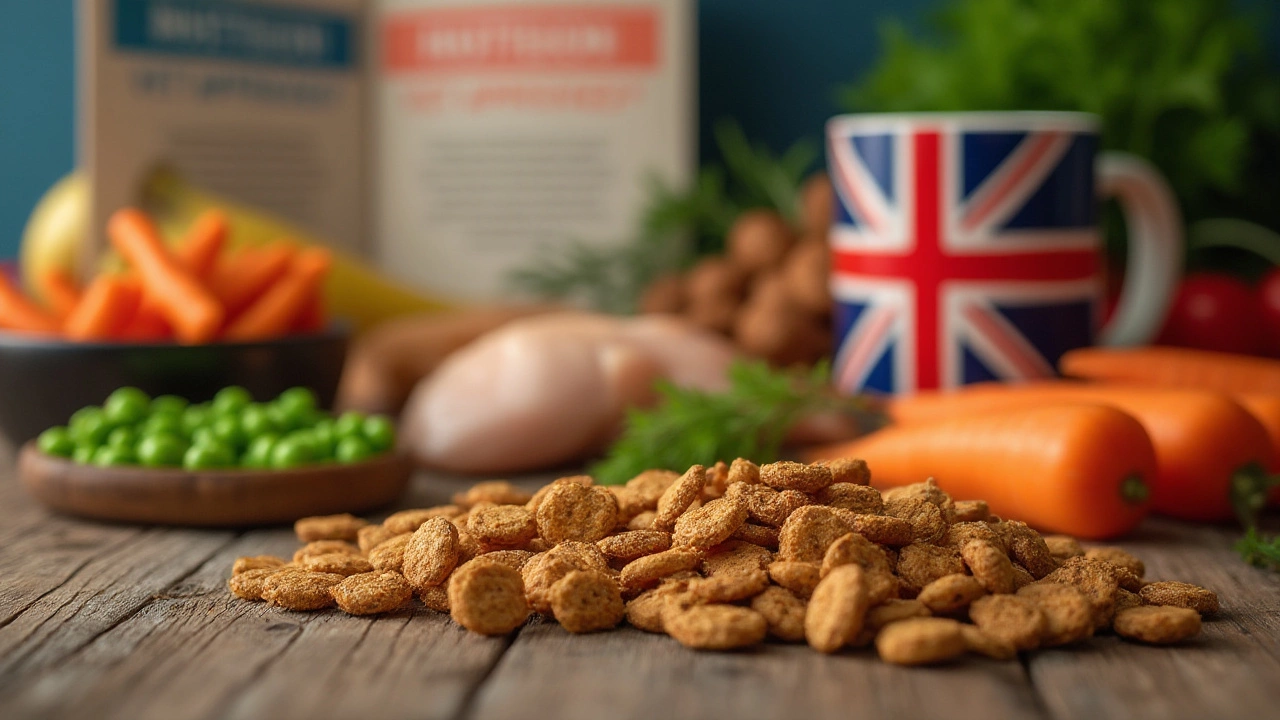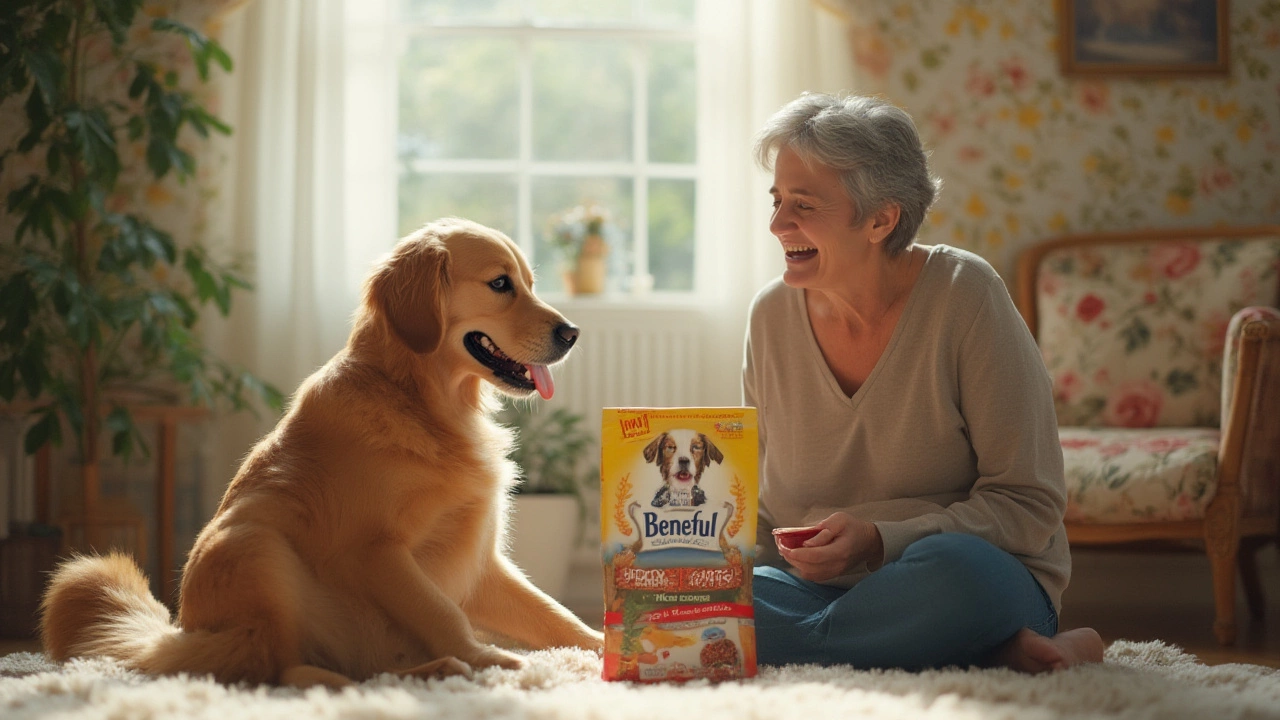Picture this: You're standing in the dog food aisle, dozens of bags staring back at you. Then you see Beneful, with its colorful packaging and promises of real beef, spinach, peas, and carrots. But you pause—lately, people are talking. Is Beneful really ok for your dog, or is it just clever marketing wrapped around a bowl of potential problems? The answer isn't as simple as yes or no, and every pet owner wants to give their dog the best. Let's pull back the curtain and get honest about Beneful.
What Exactly Is Beneful? A Look Behind the Brand
Beneful is one of the big dogs, pun intended, in the commercial pet food world. Under the Purina umbrella since 2001, Beneful offers everything from dry kibble to wet meals, even treats, with labels that shout "real" meats and veggies. Their commercials play up energy, shine, and flavor, saying that dogs not only love the taste but thrive on it.
But what’s actually in the bag? Beneful’s main lines—like Originals with Real Beef or Healthy Weight—start with ingredients such as ground yellow corn, chicken by-product meal, corn gluten meal, whole wheat flour, and a protein source like beef or chicken. There are also bits of veggies and synthetic nutrients, all aiming to deliver a balanced "complete and balanced" meal per AAFCO standards. Many dog owners are drawn in by those vibrant vegetable pieces you can actually see. The food seems vibrant, with primary colors supposed to echo ideal nutrition.
Purina claims their formulas are backed by over 500 nutritionists, veterinarians, and scientists. They also state all their U.S. plants go through stringent safety checks. That said, Beneful was hauled into headlines in 2015 due to a class-action lawsuit, when some pet owners alleged the food made their dogs sick. The FDA never found a causal link between Beneful and any widespread illness, but internet rumors still lingered. The brand weathered the storm and kept its product line on shelves.
If you flip a Beneful bag, you’ll also find the calorie count, feeding suggestions, and sometimes explanations about special ingredients like "accented with spinach" or "with turkey and sweet potatoes." Still, it can be a maze trying to figure out whether those ingredients are actually the best choice for your pup.
What Ingredients Set Beneful Apart?
Dog parents love to analyze ingredient lists, and Beneful sparks debate for several reasons. First, corn and whole wheat flour show up near the top of the list. These are carbohydrate sources, not inherently bad, but they’re cheaper than meat and present in higher quantities in Beneful than in some premium or "boutique" brands. Dogs are omnivores and can digest grains, but meat-based protein is still crucial for muscle and energy, especially in active breeds.
Meat byproducts and “meals” like chicken by-product meal or animal digest often trigger a reflex of suspicion. By AAFCO’s definition, by-products can include organ meats (liver, kidney), which are nutritious, but they can sometimes also include other parts left after processing. The regular customer can’t tell exactly what’s in each batch, but Purina insists these are safe and vital sources of protein, vitamins, and minerals.
Then there’s artificial coloring and preservatives. Beneful’s kibbles often look far too bright to be natural, thanks to color additives like Red 40, Yellow 6, Blue 2. These dyes aren’t toxic in small amounts, but critics argue they do nothing for dog health—they’re just for us humans to ooh and ahh over. As for preservatives, Beneful uses standard ones (such as BHA, BHT, and ethoxyquin are generally not present), but always scan the label. If your dog is extra sensitive or allergic, you might prefer a food with all-natural color and preservation methods.
On the nutrient front, Beneful meets the minimum standards for protein, fat, and carbohydrate recommended by the AAFCO. Here’s a quick rundown of typical values in "Beneful Originals with Real Beef":
| Nutrient | Minimum Guaranteed |
|---|---|
| Protein | 22.0% |
| Fat | 12.0% |
| Fiber | 3.0% |
| Moisture | 14.0% |
| Calories (per cup) | 333 kcal |
Compare this with boutique grain-free options, and you often see higher meat protein and lower carbs, but not every dog needs a ton of meat or zero grain. If your dog isn’t allergic or sensitive to grains, there’s no clear reason to steer clear.

What Do Vets and Experts Say About Feeding Beneful?
This is where things get interesting. The phrase "is Beneful good for dogs" comes up in vet offices all the time. Most veterinarians will tell you: the dog food that meets the nutritional standards, passes safety inspections, and keeps your dog healthy, vibrant, and maintaining a good weight is generally considered "ok." Beneful ticks these boxes. It’s certified as complete and balanced by AAFCO for the life stages listed on its packaging.
Yet some vets prefer foods with more transparency in ingredient sourcing. They like brands that specify meat as the number one ingredient and use less filler. For dogs with allergies, sensitive stomachs, or chronic conditions, many vets steer owners away from food with artificial colors and plenty of corn or wheat. On the other hand, most healthy dogs digest Beneful just fine.
The 2015 controversy (that class-action lawsuit which was later dismissed) still comes up on dog forums. The FDA did not find any evidence that Beneful contained harmful toxins or contaminants at concerning levels. Beneful responded with third-party lab results and continues to undergo Purina’s standard safety checks, just like any food made in the U.S. factory. The pet food industry isn’t perfect—recalls can happen to any brand. What matters is quick, transparent responses and ongoing testing.
If your dog is eating Beneful, loves it, and looks healthy—good weight, shiny coat, bright eyes, playful spirit—you’re probably on the right track. But if you notice digestive upset, itching, excessive shedding, or your dog just doesn't seem as perky, try changing their food and see if it helps. No single dog food fits every dog. Each pup's genetics, gut, and tastes are unique.
Always talk to your vet about your dog’s diet, especially if starting a new brand or recipe, or if your pet has special health needs. Even for average healthy dogs, an annual check-up is a chance to tweak their food, serving sizes, and feeding habits. Some vets may even recommend supplementing kibble with fresh foods like pumpkin, boiled chicken, or green beans to boost nutrition without overloading on calories or unneeded fillers.
The Pros and Cons: Is Beneful Right For Your Dog?
is beneful good for dogs is probably what you typed into Google while second-guessing the bright bag in your shopping cart. Like every pet food, Beneful isn’t perfect. Here’s how it shakes out if you break it into pros and cons.
- Affordability: Beneful is usually much cheaper than boutique and fresh food brands. If you’re feeding a big dog or a multi-dog home, cost matters.
- Easy to Find: It's available almost everywhere, from the grocery store to big box chains, so you won’t have to hunt down special shops.
- Meets Safety and Nutrition Standards: Beneful meets AAFCO’s minimum nutrient requirements for dogs. Calories are clearly listed, so portion control is easy for weight management.
- Variety: You’ll find recipes for puppies, adults, seniors, and need-based blends like "Healthy Weight." There are wet foods and treats too if you like to rotate textures or flavors.
But there are definite cons, too:
- Lower Meat Content: Meat often comes second to grains or meat meal in the ingredient list. Higher meat foods generally cost more but may suit very active or sensitive dogs better.
- Artificial Colors: Those bright red, yellow, or green kibble bits don’t do anything for dog health. If your pup is sensitive, these might cause trouble.
- Controversial Ingredients: Some dogs thrive on grains, but others with allergies need grain-free or limited-ingredient foods. Always scan for specific allergens.
- No Single "Best" Recipe: The "best" food is the one your dog does well on. Beneful may be the perfect fit, or it might not suit your dog’s individual needs.
If you're debating, try a small bag first. Watch your dog for at least three weeks: stool quality, energy level, coat, itchiness. Also, check your dog's breath and weight. Consistent vomiting or diarrhea means swap foods. If you see improvement in coat shine, energy, or tummy troubles after switching away from Beneful, you may have found an answer for your individual pup.

Tips for Choosing the Best Food for Your Dog
Dog food shopping feels easier when you break it down into steps. Here are ways to quickly size up if Beneful—or any dog food—fits what your dog needs:
- Check the First Five Ingredients: These make up most of what’s in the bag. More named meat (like "beef" or "chicken") usually equals higher protein and better digestibility.
- Understand Protein Sources: "By-product meal" isn’t necessarily bad, but if your dog is sensitive, look for single protein sources and fewer plant fillers.
- Look for Specific Allergens: Know if your pup has reactions to certain grains, chicken, beef, or additives. Avoid foods that contain these triggers.
- Match the Food to Your Dog’s Age and Lifestyle: Puppies, adults, seniors, and active breeds all need different levels of protein and calories. Beneful offers formulas for most.
- Taste Test: Dogs have their own flavor favorites. Many turn up noses at certain commercial foods. Start small and see how your dog responds. Wet food may boost appetite in picky eaters or seniors with bad teeth.
- Read Reviews and Vet Opinions: Sure, online reviews can be overwhelming, but look for consistent themes, not one-off horror stories or glowing praise. Asking your vet (who handles lots of breeds and brands) can cut through the noise.
- Monitor Results: No food suits every dog. Check for energy, skin health, weight gain or loss, stool consistency, and obvious allergic reactions.
If your dog’s nutrition gets a thumbs up at the vet each year and your dog looks and acts healthy, that’s a better sign than any marketing claim. No food is magic. Switch brands or recipes slowly over at least a week to keep doggy tummies happy.
By now, you’ve seen all sides: Beneful checks the safety boxes, shines in affordability and variety, but might fall short for dogs with specific allergies or those thriving on meat-heavy diets. The right food is the one that works in your real dog’s real body. Don’t let slick marketing, scary rumors, or internet forums make you second-guess what you see in front of you. Trust your pup, your vet, and your own common sense.
